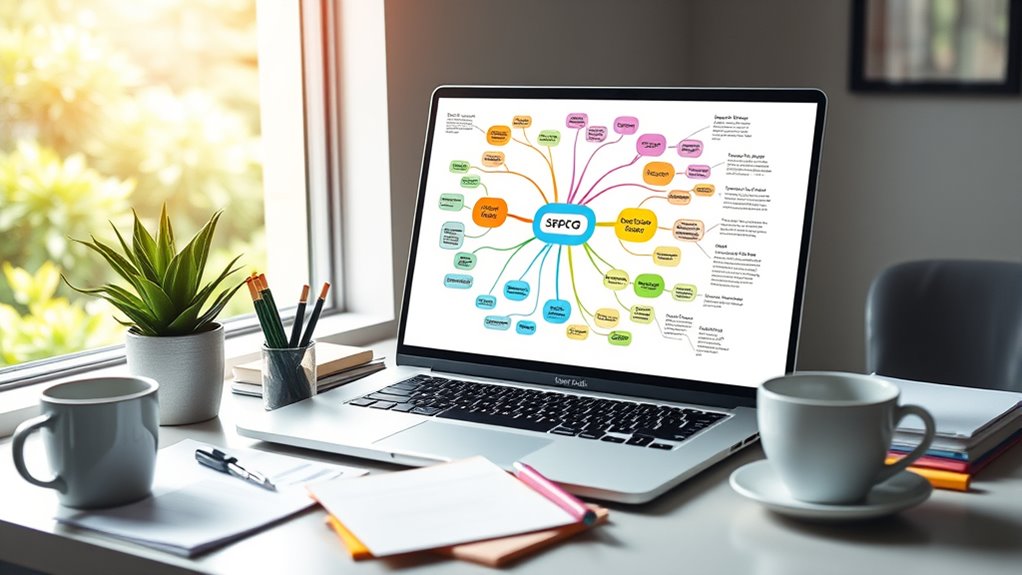To create topic clusters for SEO authority, start by identifying your core themes or pillars that align with your audience’s interests. Develop thorough pillar pages around these themes and link related subtopics throughout your site with strategic internal links using descriptive keywords. Optimize all content for relevance, quality, and user intent. Continuously monitor performance and refine your approach. If you keep exploring, you’ll gain deeper insights into building a powerful, organized content strategy.
Key Takeaways
- Identify and define core topics that align with your target audience’s interests and business goals.
- Develop comprehensive pillar pages for each core theme, linking to related subtopics to create cohesive topic clusters.
- Optimize content with natural keyword integration, ensuring semantic relevance and high-quality, original information.
- Use strategic internal linking with descriptive anchor texts to guide search engines and users through related content.
- Monitor performance metrics regularly to refine content, improve authority, and enhance overall SEO effectiveness.
Understanding the Concept of Topic Clusters

Have you ever wondered how some websites rank higher in search results? The key lies in creating effective topic clusters that boost your SEO authority. At their core, topic clusters improve semantic relevance by connecting related content around a central pillar. This structure helps search engines understand your site’s expertise and relevance on specific subjects. Additionally, it enhances audience targeting by organizing content in a way that guides visitors through related topics seamlessly. When your content is interconnected, it signals to search engines that your site provides all-encompassing information on a subject, increasing your chances of ranking higher. Understanding the concept of content organization enables you to optimize your website’s structure, making your content more accessible and authoritative for both users and search engines.
Identifying Core Themes and Pillar Content

Start by defining your key topics that resonate with your audience and support your business goals. Next, develop clear and exhaustive pillar pages for each core theme to serve as authoritative hubs. Finally, map related content around these pillars to create a cohesive and effective topic cluster that boosts your SEO authority. Incorporating core themes related to understanding narcissism, such as signs and symptoms, family dynamics, and management strategies, will strengthen your content architecture and improve search engine rankings.
Defining Key Topics
How do you guarantee your SEO efforts are focused and effective? The key is defining your core topics clearly. Start by identifying themes that hold semantic relevance to your target audience and business goals. These core themes become your key topics, guiding content creation and structure. Make certain your topics encompass a broad keyword diversity, covering various related search terms to attract diverse traffic. Focus on establishing a few well-defined, authoritative core themes rather than scattering efforts across too many areas. This clarity helps search engines understand your site’s focus, boosting your authority. When you define key topics precisely, you create a solid foundation for building effective topic clusters that improve your SEO performance. Additionally, considering content relevance ensures your topics stay aligned with what your audience is searching for and interested in.
Developing Pillar Pages
Developing pillar pages begins with clearly identifying your core themes—those key topics you previously defined. These core themes form the foundation for your pillar content, which should serve as exhaustive resources. To engage your audience effectively, use visual storytelling techniques that make complex information more accessible and memorable. Understanding your audience segmentation helps you tailor your content to meet specific needs and interests. Your pillar pages should cover broad topics while linking to related subtopics, creating a strong internal linking structure. This approach not only improves SEO authority but also encourages visitors to explore more of your site. Incorporating energetic alignment into your content strategy can amplify the effectiveness of your messaging and foster deeper engagement. Focus on clarity and relevance, ensuring each pillar page clearly communicates its core message and supports your overall content strategy.
Mapping Related Content
Mapping related content involves identifying the core themes that underpin your overall content strategy and determining which topics will serve as the foundation for your pillar pages. You need to analyze your existing content, spotting patterns that reflect audience interests and search demand. Focus on content diversification by covering different facets of each core theme to attract a broader audience. Audience segmentation helps you tailor your content to specific groups, ensuring your core topics resonate with their needs. By mapping related content, you create a clear structure that links subtopics to your pillar pages, strengthening your SEO authority. Incorporating space-saving solutions into your content strategy can also highlight innovative ways to optimize home organization. This process guarantees your website becomes a thorough resource, making it easier for search engines and users to navigate and find relevant information.
Planning Supporting Content and Subtopics

Have you considered the importance of planning supporting content and subtopics when building a strong topic cluster? Effective content planning guarantees that each piece aligns with your main topic while addressing different audience needs. Start by identifying subtopics that fill knowledge gaps and attract targeted segments. Audience targeting helps you create content that resonates, increasing engagement and authority. When planning, consider the questions your audience asks and the keywords they use. Supporting content should be thorough yet focused, reinforcing your core topic without redundancy. Incorporating emotional support strategies can enhance the relevance and utility of your content, especially when addressing sensitive topics like divorce. This strategic approach helps search engines understand your expertise, improves ranking potential, and provides your audience with valuable, relevant information. Proper planning ensures your topic cluster grows cohesively, establishing your authority and boosting your SEO performance.
Structuring Internal Links for Maximum Impact

To maximize the effectiveness of your topic cluster, structuring internal links strategically is essential. You want to guide visitors smoothly through related content, helping search engines understand your site’s hierarchy. Use descriptive anchor text that clearly indicates the linked page’s topic, boosting relevance and user experience. When you link from high-authority pages, you pass valuable link juice to supporting content, increasing its chances to rank higher. Avoid generic phrases like “click here”—instead, craft specific, keyword-rich anchor text. Place links logically, connecting related subtopics to your pillar page, creating a strong internal network. Proper internal linking not only enhances navigation but also signals to search engines which pages hold the most importance, ultimately strengthening your overall SEO authority. Incorporating content about well-being tips can further establish your site’s expertise and authority in health and wellness.
Implementing SEO Best Practices Within Clusters

To reinforce your topic clusters, you need to focus on effective keyword optimization strategies that align with your content themes. Implement internal linking techniques that guide both users and search engines through your cluster seamlessly. Additionally, maintain high content quality standards to establish authority and ensure your pages meet your audience’s expectations. Leveraging AI-driven analysis can further refine your strategy by identifying relevant keywords and content gaps to maximize your SEO impact.
Keyword Optimization Strategies
Wondering how to maximize your SEO efforts within topic clusters? Focus on keyword optimization by ensuring semantic relevance across your content. Use keywords naturally within your text, avoiding keyword stuffing that inflates keyword density. Instead, prioritize contextually relevant terms that resonate with your audience and search engines alike. Incorporate primary keywords strategically in headings, subheadings, and throughout the content to reinforce topic authority. Remember, maintaining a balanced keyword density helps search engines understand the focus without appearing spammy. By aligning your keywords with the overall theme of each cluster, you strengthen the relevance of your content, boosting your chances of ranking higher and establishing authority within your niche. Additionally, leveraging all Waterparks as a core concept ensures your content remains comprehensive and authoritative in your niche.
Internal Linking Techniques
Have you considered how internal linking can enhance your SEO within topic clusters? Using strategic anchor text helps guide both users and search engines through your content, reinforcing relevance. When you link related articles within a cluster, guarantee your anchor text is descriptive and keyword-rich, which boosts your site’s topical authority. Proper internal links distribute link equity across your pages, improving their ranking potential. Focus on linking from high-authority pages to supporting content, creating a strong internal network. Avoid generic phrases like “click here”—instead, use specific keywords that reflect the linked page’s topic. This approach not only enhances user experience but also signals to search engines how your content is interconnected, maximizing the SEO benefits of your topic clusters. Additionally, ensuring your internal links emphasize building resilient online communities can support your overall content strategy by fostering trust and engagement.
Content Quality Standards
Building on effective internal linking, maintaining high content quality within your topic clusters guarantees your site remains authoritative and valuable to users. Focus on content originality to provide unique insights that set you apart and build trust. Adhere to readability standards by organizing information clearly, using short sentences, headings, and simple language to enhance user experience. Consistent quality not only improves engagement but also signals to search engines that your site is a reliable authority. Avoid duplicate content and ensure every piece contributes fresh, relevant value. By prioritizing originality and readability, you create a cohesive cluster that boosts SEO performance and keeps visitors coming back for more. High-quality, original content within your clusters is essential for long-term search visibility. Incorporating aquatic exercise information can diversify your content and appeal to a broader audience interested in water-based fitness options.
Monitoring and Refining Your Cluster Strategy

To guarantee your topic cluster strategy remains effective, you need to continuously monitor its performance and make data-driven adjustments. Track key metrics like audience engagement, page views, and bounce rates to identify what’s working and what isn’t. If certain topics aren’t resonating, consider a content refresh to update and optimize those pages. Regularly reviewing your internal linking structure ensures your clusters stay logical and easy for both users and search engines to navigate. Pay attention to keyword rankings within your cluster and adjust your content to target high-value opportunities. Incorporating insights from content performance analysis helps you understand how your content is performing and where improvements can be made. By staying proactive and refining your strategy based on real data, you strengthen your authority, improve user experience, and sustain your SEO success over time.
Frequently Asked Questions
How Long Does It Typically Take to See Results From Topic Clusters?
You might wonder how long it takes to see results from topic clusters. Typically, you’ll notice improvements in content relevance and ranking within three to six months. However, it depends on your website’s authority and the competitiveness of your keywords. Consistently creating high-quality, interconnected content accelerates ranking improvement and boosts your SEO authority over time. Patience and ongoing optimization are key to maximizing the benefits of topic clusters.
Can Small Websites Effectively Implement Topic Clusters for SEO?
Small websites can certainly succeed with structured strategies like topic clusters. You can craft a clear content hierarchy, focusing on relevant, related topics, and integrate keywords seamlessly. By building a solid foundation with focused content, you boost your SEO authority without overwhelming your resources. Consistent content creation and strategic keyword integration make it manageable, helping you grow visibility and authority over time. Small sites can definitely make a mighty impact with smart, simple SEO strategies.
What Tools Are Best for Analyzing and Managing Topic Clusters?
You should focus on tools that help identify content gaps and facilitate keyword mapping. Google Search Console and SEMrush are great for analyzing your site’s performance and spotting content gaps. Ahrefs and Moz help you visualize topic clusters and manage keyword mapping effectively. These tools enable you to streamline your content strategy, make sure your topics are well-connected, and boost your SEO authority, even for small websites.
How Do You Adapt Topic Clusters for Evolving SEO Trends?
Imagine your topic clusters as a garden that needs regular tending. To adapt to evolving SEO trends, you must prune outdated content and refresh existing pages to maintain content freshness. Keep an eye on keyword cannibalization, ensuring your topics don’t compete. Regularly analyze your clusters, update keywords, and add new content to stay relevant, much like nurturing your garden to thrive amid changing seasons.
Are There Common Mistakes to Avoid When Creating Topic Clusters?
When creating topic clusters, you wanna avoid common mistakes like duplicate content that confuses search engines and keyword cannibalization, which can hurt your rankings. Make sure each cluster is well-organized and unique, with clear, targeted keywords. Don’t overlap topics excessively, and guarantee your internal linking strategy is logical. These steps help improve your SEO authority and prevent issues that could undermine your efforts.
Conclusion
By weaving your content into a tight-knit web of topic clusters, you’ll turn your website into a thriving garden of authority. Like a skilled gardener tending to each plant, keep nurturing your core themes and supporting pieces. With strategic internal linking and ongoing refinement, your site will bloom higher in search rankings, attracting more visitors. Embrace this approach, and watch your SEO efforts grow into a powerful, unstoppable force.









